Anthurium leaves turn yellow: why and what to do?
Among gardeners, anthurium is considered a rather capricious plant to grow. However, it is not. It is enough to provide the flower with conditions that meet its needs, and it will not require any special labor costs. It is mistakes in leaving that often explain why anthurium the leaves turn yellow. But first things first.
Content:
- Description of the plant
- Leaves turn yellow - the reason: improper care
- How to properly care for a flower?
- What to do in case of diseases of the root system?
- Leaves turn yellow after transplanting
- Leaves turn yellow - the reason: diseases and pests
Description of the plant
Anthurium - an evergreen plant, belongs to the Aroid family (Araceae). Comes from the rainforests of South and Central America. In nature, a flower can exist in different forms:
- epiphytes that live on trees and feed on aerial roots
- terrestrial
- lithophytes who have adapted to life on rocks, etc.
Anthurium has thick stems, short or elongated, depending on the type of plant. The leaves are usually leathery, matte or glossy. The shape of the leaves is varied: round, spatulate, heart-shaped. Inflorescence is an ear of small flowers, around which a so-called veil is wrapped. It can be in various shades of white, green, pink, red and even purple.
Because of this appearance, the plant is called "flamingo flower".
In room culture, there are both decorative leafy species (crystal anthuriums, Hooker, Veich) and flowering ones - these are the most popular among flower growers Andre's anthurium and Scherzer's anthurium.
Leaves turn yellow - the reason: improper care
A resident of the tropics, anthurium loves warmth, humidity and diffused light. It can react to changing conditions by yellowing the leaves.
- Are the leaves covered with yellow spots on the underside, which then turned brown? Most likely, this is the result of hypothermia. For example, a pot with a plant is on a cold windowsill or in a draft. Or, after buying on the way from the store to the house, the flower was for some time at subzero temperatures.
- The color of the leaves of anthurium is affected by the mode lighting... So, with a lack of light, the leaves turn pale and yellow, and with an excess of it (especially under direct rays), the flower will easily receive a sunburn, which will manifest itself in the form of ugly pale or yellow-brown spots.
- Complete yellowing of several leaves may indicate a problem with root system... Namely - about its decay. The plant is flooded, depriving the roots of the necessary oxygen. The situation is aggravated at high density and low soil temperature, when evaporation is slower. A long absence of watering (overdrying the soil) can also provoke yellowing of the leaves.
- Not only the temperature of the content and the frequency of watering are responsible for the healthy appearance of the anthurium. It is important what kind of water is used. Watering with hard water with an excess of salts and chlorine can lead to yellowing of the leaves.
- Excessive use of fertilizers, especially on dry soil, leads to root burns. It can also cause yellowing of anthurium leaves.At the same time, old leaves are more often affected, and new ones grow healthy. In this case, it is recommended to refrain from fertilizing for at least a month and observe the plant. Lack of mineral elements in the soil can cause discoloration of the leaves. With a lack of iron, chlorosis develops. In this case, it is recommended to use fertilizers containing iron, as well as water the plant with acidified water.
Finally, the lower leaves of anthurium turn yellow and fall off simply from old age. If the plant is actively releasing young leaves and blooming, there is nothing to worry about. The only trouble is that the anthurium loses its decorative appearance due to the exposure of the stem. In this case, the top of the plant is cut off and rooted in a wet sphagnum or water. Lateral processes may appear on the lower remaining part.
How to properly care for a flower?
Most of the trouble with a flower is due to mistakes in care, when the plant is simply in the wrong conditions for it. Anthurium is considered a rather capricious plant for home cultivation.
Consider the basic requirements for its content:
- Lighting... Bright but diffused. Avoid direct sunlight. The optimal content of anthurium is considered to be on the western and eastern windows. Additional lighting is required in winter. If it is impossible to provide it, the temperature of the content is reduced to 18 C (not lower), watering is reduced.
- Air temperature. Hypothermia is fatal for anthurium. The optimum temperature is 18-25 ° C. Drafts and sudden temperature changes are unacceptable. It is also undesirable to keep the flower near a working battery. In this case, you need to constantly keep a wet blanket or towel on it.
- Air humidity. Anthuriums require high air humidity. It is advisable to spray the leaves (but not the flowers) with warm, settled water every day. Beautifully flowering species tolerate the dry air of an apartment better than decorative leafy ones. For the maintenance of the latter, special conditions are required (mini-greenhouse, greenhouse, florarium).
- The soil. Like all aroids, anthurium needs a light, slightly acidic soil. You can purchase a ready-made specialized mixture or prepare the substrate yourself. To do this, take 50% of universal soil (with humus and high moss peat) and 50% of additives (a mixture of coke fiber, pine bark, vermiculite, coal, perlite, sphagnum moss). During the mixing stage, the ingredients are slightly moisturized. Such a substrate will pass air well to the roots.
- Watering... Use only soft, settled water, preferably boiled or filtered. Lemon juice or citric acid can be added to the water to acidify the soil. Room temperature or slightly higher. The earthen lump should be completely saturated, but without stagnation of water in the sump. Watering should be uniform and regular, as soon as the topsoil dries out (but not less often). The main rule is not to flood the plant! In winter, watering is reduced.
Fertilizers are applied during the period of plant growth. A complex mineral fertilizer is used, reducing the concentration indicated in the instructions by 4 times.
What to do in case of diseases of the root system?
Very often, yellowing of the leaves signals the florist about problems in the root system of the anthurium. Excessive watering and hypothermia lead to the appearance of rot, the development of fungal and bacterial diseases.
If you suspect root rot, perform the following actions:
- the plant is pulled out of the pot and the earth is shaken off very carefully
- the roots are carefully examined
- rotted roots are removed to healthy tissue with a sharp knife, the sections are sprinkled with crushed activated carbon and dried
- the plant is transplanted into a new pot according to the size of the updated root system (i.e. smaller diameter than the previous one)
- adjust conditions of detention anthurium
In a situation where most of the leaves have turned yellow and disappeared, that is, with severe root damage, resuscitation measures are carried out:
- the affected leaves are removed
- the remaining leaves are treated with stimulating drugs (for example, Epin)
- the roots are cut to healthy tissue, processed fungicidal preparation, wrapped in moist sphagnum moss and placed in a transparent glass with drainage holes
- the plant is placed under phytolamp in a mini-greenhouse with high humidity
- in the greenhouse, the plant is not watered, the shelter is removed daily for 15-20 minutes for airing
- if the roots are completely rotten, the stem can be placed in water with the addition of activated carbon
- after the roots grow back, anthurium is planted in a loose substrate for orchids
- when the plant gets stronger, it is transplanted into permanent soil
Leaves turn yellow after transplanting
If, after transplanting, the leaves of the anthurium began to turn yellow, this may indicate damage to the root system during transplanting, excessive flooding, improper choice of soil, or the usual adaptation of the plant to a new soil. Anthurium is transplanted every 1-2 years. Regular replanting is necessary in order to renew the depleted soil and allow the root system to grow.
Important! Anthurium has a very delicate root system, so it is not recommended to disturb it unless absolutely necessary.
A healthy plant is transplanted only by the transshipment method so as not to injure the roots. When buying Dutch plants, flower growers recommend immediately replanting anthuriums with a complete replacement of the soil and thorough washing of all roots in order to avoid problems with growing in the future. Care must be taken when washing. Root damage can cause rot and, as a result, yellowing and leaf litter.
If the purchased plant is transplanted by the transshipment method, in one pot there will be two soils ("store" and your own), differing in water and air permeability, nutritional properties. From here there will be difficulties with fertilizers and watering, the soil will not be moistened evenly. A complete substitution of the substrate will help the purchased plant adapt faster. The first month after transplantation, the flower is not fed.
When transplanting, special attention should be paid to the choice of a pot. It is categorically impossible to plant anthurium in a large pot at once. The capacity must be selected according to the volume of the root system and with each transplant increase by one size (so that a finger passes between the old earthen lump and the edge of the pot). In a large pot, the soil will not have time to dry out, which again can cause stagnant water and root rot. Good drainage at the bottom is a must. Knowledgeable flower growers do not recommend watering aroids for at least 3 days after transplanting. You can organize a greenhouse for the plant and spray the leaves regularly.
Leaves turn yellow - the reason: diseases and pests
Above, we examined the most common causes of yellowing of leaves in anthurium, associated with errors in its content. Miscalculations in care can cause the appearance of diseases and pests.
- In addition to the rot of the root system, which has already been mentioned, anthurium is susceptible to leaf spot - anthracnose. This serious condition can be treated with fungicidal preparations based on benomyl (use according to instructions). Damaged leaves must be removed and destroyed.
- Yellowing can manifest the work of a spider mite, which sucks juice from the leaves, which makes their color pale. With a small defeat, the pest is fought with folk remedies: the leaves are thoroughly washed with soapy water, sprayed with onion and garlic infusion. With a large number of parasites, acaricides are used.
Thus, the guarantee of a beautiful and healthy appearance anthurium - proper care. The main rules to be followed are: warmth, no drafts, correct soil, tight pot, diffused light, regular moderate watering.
More information can be found in the video:



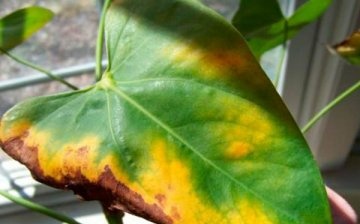
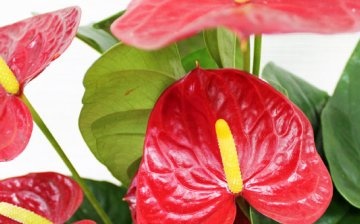
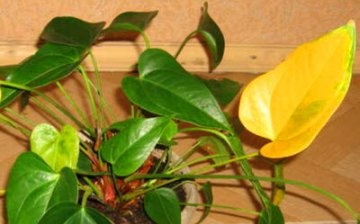
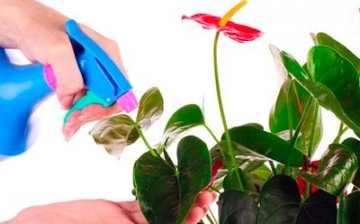
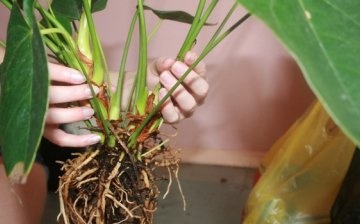
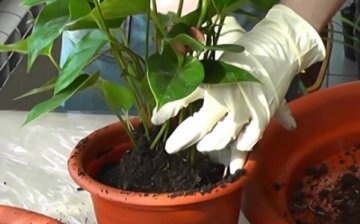
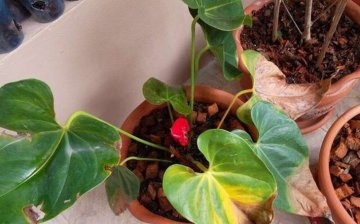







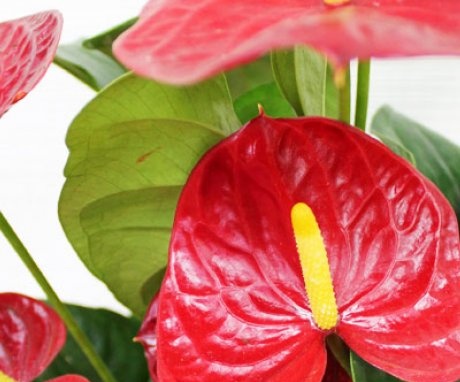
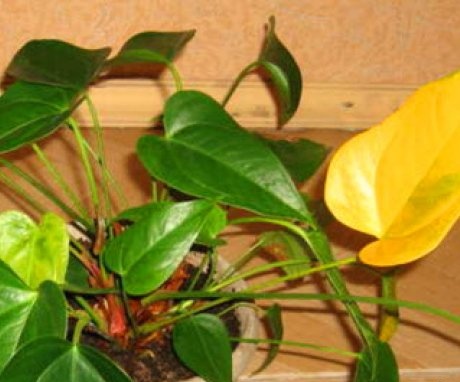
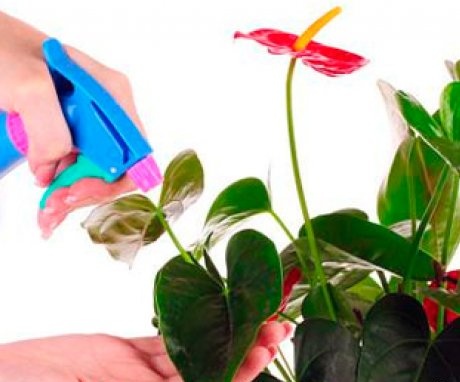
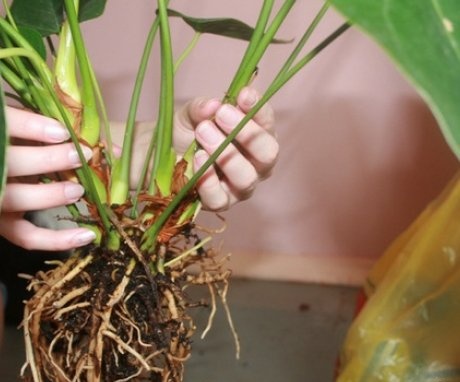
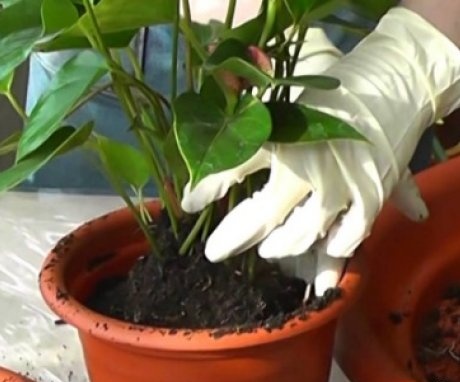
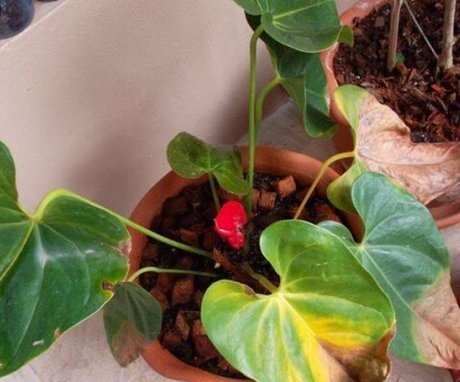
A very beautiful plant Anthurium, but despite the fact that it was brought from the humid, tropical forests of South America. In a flower pot, there must be good drainage, and the leaves must be sprayed with water in summer.
And what kind of drainage to use, because in stores there is simply an abundance of everything
Beautiful flower. My grandmother has it. However, she never came across the fact that his leaves turned yellow, although she did not particularly look after him ... I did not know that he was capricious.
Several times I was given this wonderful flower, but it never took root in my house. It was such a picture with yellowing leaves, and then the plant died altogether. I sprayed and tried to water by immersion, but I did not manage to admire its beauty for a long time.
Please tell me what kind of soil is better to use for anthurium, or can you just plant it in the ground? *